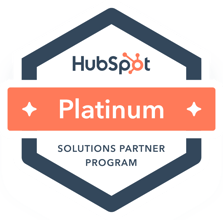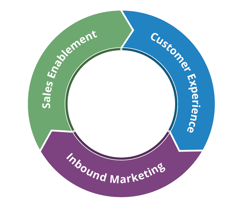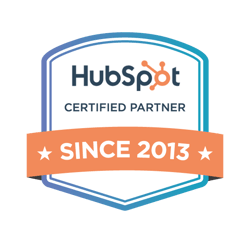Inbound marketing is about attracting, engaging, and delighting your audience by providing valuable content and experiences tailored to their needs. Whether you’re a seasoned marketer or just beginning to refine your inbound strategy, there’s always room to enhance your approach. To help you kickstart the holiday season and plan for the year ahead, we are breaking down 12 days of inbound marketing tips on our social media channels and wanted to share each of those tips with you. Each one is designed to help you attract quality leads, build meaningful relationships, and drive sustainable growth for your business.
Day 1: Define Your Buyer Personas 👥
Before diving into any marketing tactic, it’s essential to have a clear understanding of who you’re targeting. This involves creating a detailed buyer persona, a comprehensive representation of your ideal customer. A well-crafted buyer persona allows you to tailor your messaging and content to meet your audience's specific needs and preferences. To develop these personas, identify key demographics such as age, gender, location, and income level. Delve into their pain points, which are the challenges or problems they face that your product or service can solve. Understanding their goals is equally important, as it helps you align your offerings with what they aim to achieve. Then, analyze their buying behaviors, including how they make purchasing decisions, what influences them, and where they typically seek information. By gathering and synthesizing this information, you can create highly personalized campaigns that capture attention and resonate deeply with your audience, ultimately leading to more meaningful engagement and higher conversion rates.
Day 2: Audit and Optimize Existing Content ✍️
Step back and thoroughly review the content you’ve already created across all your platforms. Identify which pieces drive the most traffic or conversions, as these are your high-performing assets. Analyze the elements contributing to their success, such as engaging headlines, relevant keywords, or compelling calls to action. Then, pinpoint the content that is underperforming or outdated. These pieces could benefit from a refresh or optimization to enhance their effectiveness. Conduct a comprehensive content audit, examining each piece for relevance, accuracy, and alignment with current trends and audience interests. Update older content with new data, incorporate trending keywords, and enhance visuals to make them more appealing and informative. Consider adding multimedia elements like videos or infographics to enrich the user experience. By revitalizing your existing content, you can maximize its impact, extend its lifespan, and ensure it continues to engage and convert your audience effectively.
Day 3: Create High-Quality, Long-Form Content 📝
Search engines often prefer long-form content because it provides substantial value and depth, which is crucial for user engagement and optimization. This type of content is typically more detailed and informative, allowing you to delve deeply into topics that matter to your audience. You can thoroughly address your audience's specific needs and questions by creating comprehensive blog posts, in-depth guides, or extensive eBooks. The detailed nature of long-form content allows you to naturally incorporate a wide range of relevant keywords and phrases, improving your chances of ranking higher for various search queries. Additionally, consistently producing high-quality, long-form content establishes yourself as a thought leader in your industry. This positions your brand as a trusted source of information, encouraging more visitors to return to your site for insights and solutions.
Day 4: Develop a Content Calendar 📆
Consistency is a fundamental element in achieving success with inbound marketing. It ensures your audience knows when to expect new content, which helps build trust and anticipation. By developing a comprehensive content calendar, you can plan and organize your marketing efforts, making them strategic and more effective. This calendar serves as a roadmap for your content creation and distribution, allowing you to schedule blog posts, social media updates, email campaigns, and other marketing activities well in advance. By doing so, you can align your content with significant events, product launches, and holidays, ensuring your messaging is timely and relevant. This proactive approach helps maintain a steady flow of content and allows you to capitalize on seasonal trends and opportunities, ultimately enhancing your brand's visibility and engagement with your target audience.
Day 5: Implement SEO Best Practices 💻
Search Engine Optimization (SEO) is the backbone of inbound marketing, serving as a mechanism for driving organic traffic to your website. It involves a strategic approach to ensure that search engines quickly discover your content, which increases your visibility to potential customers. To achieve this, it's essential to focus on several key aspects of SEO. Start with comprehensive keyword research to identify the terms and phrases your target audience is searching for. This will guide you in creating content that aligns with the interests and needs of your prospects. On-page optimization is another critical component, which includes crafting engaging and relevant headings, writing compelling meta tags, and using descriptive alt text for images to enhance accessibility and searchability. Finally, technical SEO ensures your website performs well in search engine rankings. This involves optimizing site speed to provide a fast and seamless user experience and ensuring your site is mobile-friendly, given the increasing number of users accessing content via smartphones and tablets. By addressing these elements, you can significantly improve your website's search engine performance, attract more visitors, and convert them into loyal customers.
Day 6: Leverage Email Marketing 📬
Email marketing remains one of the most effective inbound marketing tools due to its ability to deliver targeted messages directly to your audience's inbox. This direct line of communication allows you to build and maintain relationships with your leads by creating segmented, personalized email campaigns that guide them through the buyer’s journey at their own pace. By segmenting your email list based on demographics, behavior, or past interactions, you can tailor your messages to meet each group's specific needs and preferences, increasing the likelihood of engagement and conversion. Focus on providing value through various content types, such as educational articles that inform and empower your audience, exclusive special offers that incentivize action, or insightful industry updates that keep them informed about the latest trends. Remember also that by regularly analyzing the performance of your email campaigns, you can refine your strategies to ensure they remain effective and relevant, adapting to the evolving preferences of your audience.
Day 7: Create Engaging Lead Magnets ⏬
Lead magnets—such as downloadable eBooks, whitepapers, checklists, or templates—are perfect tools for capturing leads by offering valuable resources in exchange for their contact information. These tools should be crafted carefully to ensure they provide high value to your audience, addressing their frequently encountered challenges or questions. For instance, an eBook could delve into industry trends or offer in-depth solutions to common problems, while a checklist might guide users through a complex process step-by-step. Whitepapers can present detailed research findings or case studies highlighting your expertise, and templates can offer practical, ready-to-use solutions that save your audience time and effort. By ensuring your lead magnets are informative and actionable, you increase the likelihood of engaging your audience, encouraging them to share their contact details in exchange for this helpful content. This exchange helps you build a robust database of potential leads and positions your brand as a trusted authority in your field, fostering longer-term relationships with your audience.
Day 8: Use Social Media to Amplify Content 👍
Social media is an excellent channel for distributing your inbound content, offering a dynamic platform to showcase your brand's voice and reach a diverse audience. By sharing various content types, such as blog posts, videos, and infographics, you can capture the attention of different segments of your audience across multiple platforms like Facebook, Twitter, Instagram, LinkedIn, and more. Each piece of content should be tailored to fit each platform's unique characteristics and user preferences, ensuring maximum engagement and visibility. For instance, visually appealing infographics and short, engaging videos might perform well on Instagram, while more detailed blog posts and industry insights could resonate with your LinkedIn audience. Engage actively with your followers by responding promptly to comments, answering questions with thoughtful insights, and participating in relevant conversations that align with your brand values. This interaction humanizes your brand and encourages a two-way dialogue, making your audience feel valued and heard. By leveraging the power of social media, you can amplify your content's reach, enhance brand awareness, and cultivate a loyal community of followers who are more likely to convert into prospects and customers.
Day 9: Implement Marketing Automation 🔄
Marketing automation is a powerful tool enabling you to nurture leads more effectively by ensuring that the right content reaches the right person at the right time. This strategic approach allows you to streamline your marketing efforts, making them more efficient and impactful. By leveraging automation tools, you can craft and send highly targeted emails that resonate with specific segments of your audience, ensuring that each message is relevant and personalized. These tools also allow you to set up automated follow-up sequences, which can be triggered based on user behavior or specific actions, such as downloading a resource or signing up for a newsletter. This ensures that your leads receive timely and appropriate communication, keeping them engaged and moving smoothly through the sales funnel. Marketing automation also helps you manage lead scoring and other sales-related initiatives, which can help assign weight and value to leads based on their interactions with your brand. This helps you to prioritize leads that are more likely to convert, allowing your sales team to focus their efforts on prospects with the highest potential. By integrating these automation strategies, you can convert prospects into loyal customers more efficiently and effectively at scale.
Day 10: Identify Content Repurposing Opportunities ♻️
Identifying content repurposing opportunities in a digital marketing program begins with thoroughly analyzing your high-performing assets to extend their reach and maximize their value. This process thoroughly examines content metrics such as engagement rates, website traffic, and conversion statistics to identify which content most effectively resonates with your audience. By understanding these metrics, you can determine which content has the potential to be repurposed into different formats or distributed across various platforms, reaching a broader audience and enhancing its impact. For instance, a well-received blog post can be transformed into a webinar, offering a more interactive experience for your audience. It can also be converted into an infographic, providing a visually appealing summary of the key points, or adapted into a podcast episode, allowing your audience to engage with the content in an audio format. Additionally, the same content can be broken down into a series of social media posts, each highlighting different aspects of the original piece to maintain engagement over time. By strategically mapping these assets to new formats, you breathe new life into existing content and ensure that your message reaches diverse audience segments, ultimately driving greater engagement and achieving your marketing goals.
Day 11: Monitor and Measure Your Efforts 📊
Data-driven decisions are critical to the success of your inbound marketing strategy, as they provide the foundation for making informed and strategic choices that can significantly impact your business outcomes. By leveraging data, you can gain valuable insights into your audience's behavior, preferences, and interactions with your brand, allowing you to tailor your marketing efforts more effectively. Use robust analytical tools like Google Analytics, HubSpot, or your preferred Customer Relationship Management (CRM) system to track key metrics such as website traffic, conversion rates, lead quality, and user engagement. These tools offer a comprehensive view of how your marketing initiatives are performing, enabling you to pinpoint which strategies are yielding the best results and which areas require further optimization. Regularly review and analyze your performance data to identify trends, patterns, and areas for improvement. This ongoing evaluation process allows you to make data-backed adjustments to your strategy, ensuring that your marketing efforts remain agile, relevant, and aligned with your business goals. By continuously refining your approach based on data insights, you can enhance your marketing effectiveness, drive better results, and ultimately achieve sustainable growth for your business.
Day 12: Focus on Conversion Rate Optimization (CRO) 📈
All the traffic in the world won’t matter if you’re not converting visitors into leads or customers, as the ultimate goal of any marketing strategy is to turn interest into tangible results (and revenue). To achieve this, it's crucial to focus on improving your website’s conversion rate, which involves a multifaceted approach to ensure every visitor has a seamless and compelling experience that encourages them to act. Start by optimizing your landing pages, which are often the first point of contact for potential customers through paid search campaigns, which could be a large source of website traffic. Ensure these pages are visually appealing, load quickly, and contain clear, concise information that aligns with the visitor's expectations. Next, enhance your call-to-actions (CTAs) by making them more prominent, persuasive, and relevant to the content surrounding them. Experiment with different wording, colors, and placements to see what resonates best with your audience. Then, simplifying the user experience is key. Remove any unnecessary steps or distractions that could deter visitors from completing their desired actions. Streamline navigation, ensure mobile responsiveness, and provide easy access to essential information. To refine these elements further, employ A/B testing, which allows you to compare different versions of your pages and CTAs to determine which variations yield the highest conversion rates. By systematically testing and analyzing these components, you can identify the most effective approach to converting visitors into loyal customers, ultimately driving growth and success for your business.
By following these 12 inbound marketing tips, you’ll be well on your way to creating a more engaging, effective, and measurable strategy now or in the new year. Whether refining existing tactics or trying new approaches, each tip will help you build stronger connections with your audience and drive sustainable growth for your business. As you move forward into the new year, remember these best practices to continually refine and improve your inbound marketing efforts.
If you're interested in discussing how to maximize your digital and inbound marketing programs in the new year, we invite you to schedule an inbound marketing consultation with our team.


__Square.png?width=250&height=250&name=Marketing_Hub_(1)__Square.png)




.png?width=250&name=diamond-badge-color%20(1).png)
